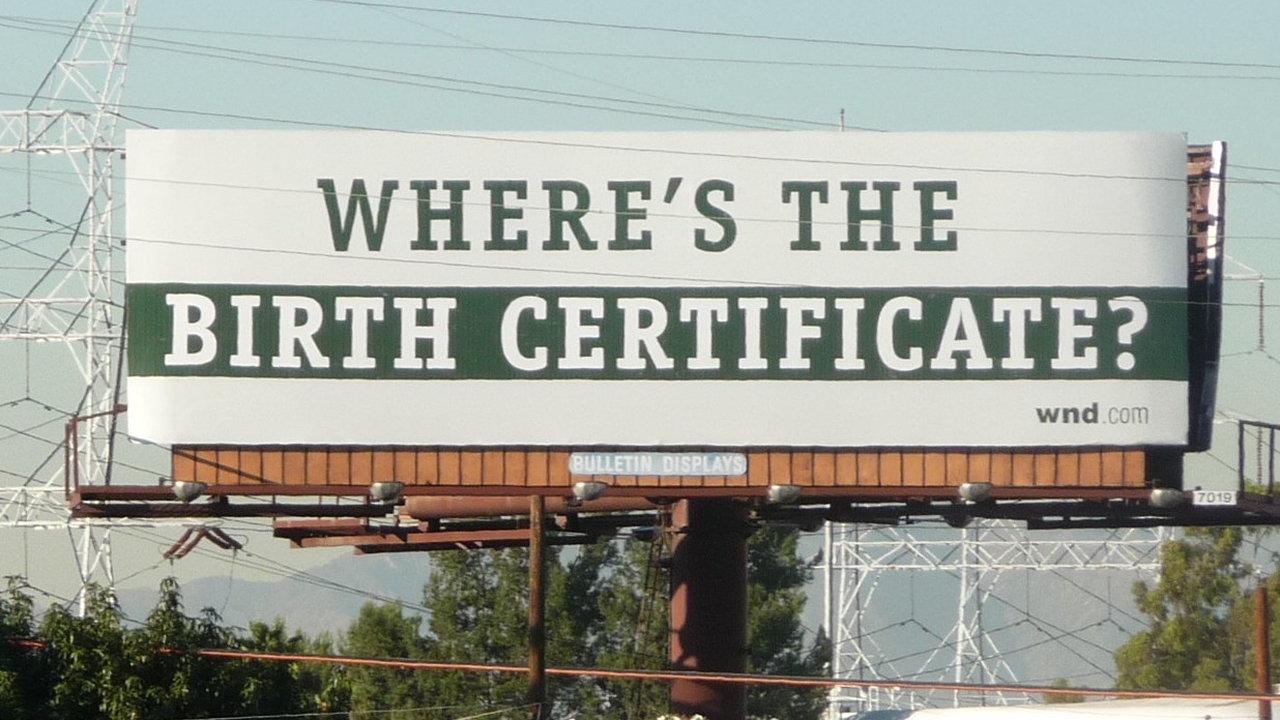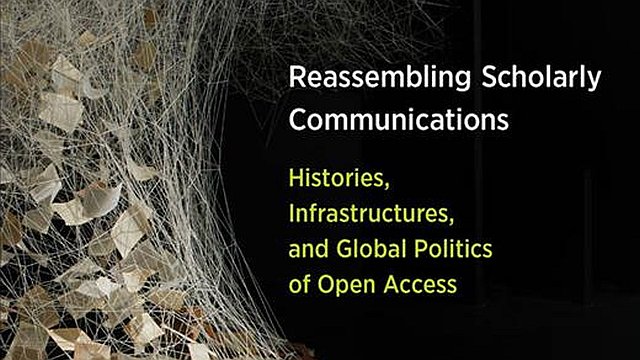
Libraries at the crossroads: Strive and thrive or resist and perish
This article recounts the findings from Dr Ra Jes Chelliah’s metropolitan public library PhD research investigation on current library services and information needs in the context of the digital environment, inclusivity and client diversity.
Regenerating, rebranding, reinventing, restructuring and redefining denote the current narrative in the public library environment around the world. These words reflect rhetoric among librarians, potentially heralding visionary innovations for future libraries.
The contents of library shelves evolved from the clay tablets of Assyria, progressing next to papyrus, parchment scrolls, mass printing on paper and on to the present day iPad tablet. Change is the consistent variable that pervades the story of libraries. The librarian, now more than ever before, confronted by compelling forces, needs to explore pathways towards rebranding their traditional library services, particularly due to rapidly increasing digital information access and the unprecedented revolutionary increases in demographic diversity. The reality confronting public libraries is momentous. Libraries are at a crossroads, either to strive and thrive or resist and perish.
The conceptual framework underpinning this article assumes that the public library is a safe and neutral government public space, and as such, has the potential to be leveraged as a platform for socio-engineered sustainable micro communities, by redefining policies and services to meet constantly changing client expectations and nation building objectives. The research findings provide evidence on current library services and programs, highlight the embedded diversities among clients, cite discrepancies in the level of information seeking skills, and elaborate on the current environment in the suburban public library.
The vital contribution of this research is a proposal for rebranding and regenerating the traditional public library. The findings of a librarian web survey and migrants’ interview data underpin the proposal for a model for sustainable libraries. The increasing tension, distrust, fear and recent tragic events in Australia, UK, USA, Europe, and other parts of the world, drive the impetus for the traditional library system, with its functionally designed infrastructure, to address the present day needs of its local residents and the nation.
The suburb (also referred to as county or shire) is the micro unit in the global geographical space. The public libraries located in this micro unit are viable, non-threatening public spaces for community engagement and integration. The proposition is for libraries to reinvent their services, and rebrand the traditional library as a platform for integrating and engaging their local residents in their catchment area, by initiating programs which focus on community sustainability and nation building objectives.
What is critical is that advocacy for rebranding and regenerating the library requires Federal Government collaboration. Efforts at rebranding requires top down national policies, which filter down to state governments, local government authorities, and then to the suburban councils. The proposition is for leveraging libraries in alignment with the government’s efforts towards rebuilding secure and safe communities, within their regular programs. Libraries around the world are at crossroads, with an urgent demand for rebranding in the context of the present day global dilemma. The public libraries have an option to address the volatile socio-political environment and optimize the moment with change which will sustain and regenerate public library institutions around the world. Rebranding as community builders and transforming as active advocates, rather than remaining as passive traditionally perceived, service providers. The model proposed for rebranding libraries superimposes practical proposals founded on policy, inclusive services, the library image and diverse audiences.
This article advocates for the urgency to optimise the current library services for increasing community building efforts, enriching social capital and supporting national goals for a cohesive nation in the context of current complex and challenging demography. The appeal is for optimal action in rebranding, re-defining and re-structuring the library system. The findings of the public library research investigation are neither a critical stance that condones the traditional library service provision, nor a stance that complies with the business as usual approach. On the other hand, this article is an assertion that, now more than ever before, stakeholders are called to review their perspectives about their suburban libraries beyond their current traditional models. Rather than stifling the traditional library system, the current social environment points towards addressing the calls of library associations, library managers, and the community leaders and clients of the library! Addressing the changing demands of the library sector, might result in dynamic rebranding with positive outcomes for the society and nation.
Stakeholders
To a large extent, any plan for gradual rebranding depends on the stakeholder. The stakeholders are key players for implementing change in the public library, these are the government officials who hold the budget allocations and negotiate policies. Rebranding the image and library services is dependent on a transparent top down process of rebranding initiatives which filters through to the local public library. Policy changes and funding at the governmental level underpin success towards rebranding, redefining and reinventing the library services, programmes and resources. Strategic asset management and a state-wide innovative library policy, handed down to State Governments, Local Government Authorities and the local councils who administer the suburban libraries, are vital processes for creating a more inclusive and sustainable library system. Figure 1 below displays the potential key players and their roles in the public library environment. Redefining this national asset for building strong communities in the local suburbs is essential for nation building in the current volatile diverse demography prevalent in our nation. The community encompasses the social capital of the nation a highly informed community, practices mutual respect, is progressive and contributes to the nation’s economy1.
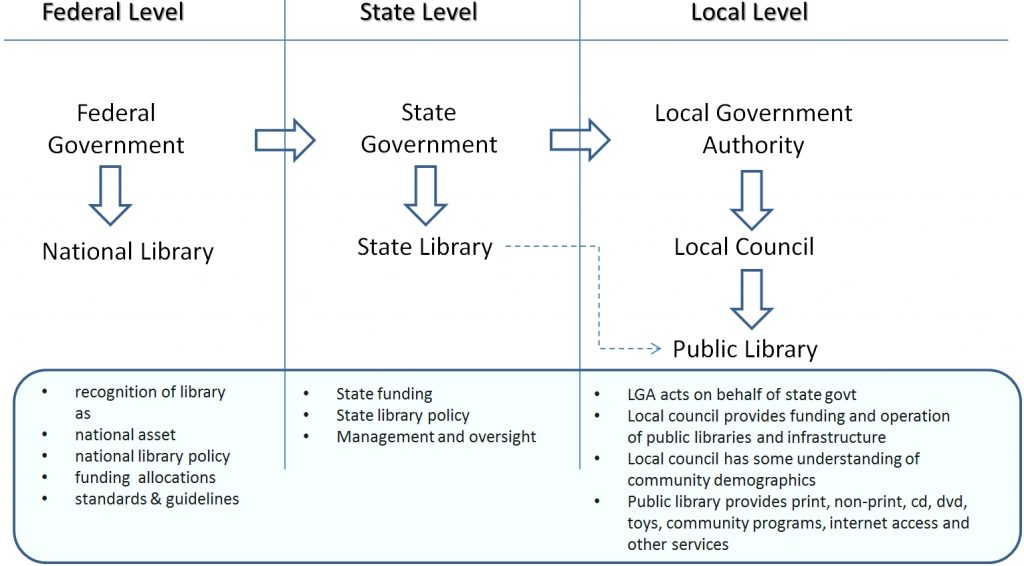
Undeniably, the public libraries are outcomes of politicians, educators and administrators. Furthermore, the research draws attention to the role of these stakeholders, whose top down hierarchy of politician, educator, administrator down to the actual service providers (librarians), is a considerable shortcoming for driving change. This top-down approach can substantially limit the effectiveness of equitable library systems, dominated as they are by those from an English (or native language) speaking background, and are not engaged with the diverse clients at library counters2.
Drivers for change
In general, stakeholders are unaware of the achievements of the agents of change, namely, the librarians at the service counters who managed the libraries’ collections, services, and clients3. As the role of stakeholders, as drivers for rebranding the library, is vital, advocacy for change needs to commence from the top level management. Rebranding and restructuring the public library, relying more on those far removed from the public library itself, such as those residing at the federal and state levels of government, is unlikely to eventuate. Rebranding requires advocacy from the grass root level of library staff, who in constant contact with the information needs of the local residents, gain knowledge about shifting dynamics within their clientele as well as those who stay away.
If lessons on public library services are emulated, the presentation presses upon the need to heed salient points about library system in the United States4. Malone5 reiterates that the U.S. multicultural library tradition symbolised the stifling of ethnic minorities by the dominant culture. In some instances, these minority groups turned the libraries around to serve their needs by collaborating with their local librarians. Information on the library field in terms of power relationships are extremely relevant in terms of describing the evolution of library services, and it provides models for emulation by librarians who are passionate drivers for change.
Evidence illustrates that there is a need for the present initiatives, to go beyond mere ethnic library collections and ethnic staff, it provokes thought about access, encourages reflections about users and those who avoided the library6. The pioneers of the multicultural public library services in the U.S. set the precedent for others to emulate and even improve, when U.K., Canada, Europe and Australia welcomed large scale migrant waves into their communities. Invariably, the librarians ascertained the level of services currently practised in public libraries. The early waves of migration heralded change to a small extent, but, two revolutionary events in the current environment demand urgent attention from the Federal government, service providers, library associations, and politicians7.
The first revolutionary impact is the transformation of traditional library services into digital systems and secondly, the increased diversity among the individuals in the emerging migrant groups, caused challenges and barriers to accessibility resulting in increased marginalisation among some sectors of the population. Clearly, the digital services rendered many as computer illiterate users due to an absence of relevant computer skills (for example, many users were unable to search for information using the digital catalogue system). Additionally, the waves of migrants, asylum seekers and boat arrivals were far more diverse than ever before. These new arrivals varied in employment skills, levels of education and held a wider variety in religious affiliations. Large scale inflow of migrants from the Middle East, Africa and South Asian nations meant that their substantial numbers met their social needs to reside independently in their adopted nation without integrating with the host culture. Thus, niche communities emerged in these multicultural advanced nations in USA, Europe, Canada, UK and Australia8. These bonding social capital groups, socialised, prayed (in mosques, temples), educated their children (in ethnic schools) and shopped (in ethnic groceries) with minimal interaction or communication with their hosts9. Lacking English they were unable to obtain jobs with mainstream employers. Hence, the stage was set for micro units of marginalization and discontent. Efforts to integrate were rejected deeming that the Western value system was noncompliant to their beliefs.
The widening gap between the “us and them” can be averted through planned intervention. One of the strategies for building sustainable societies is by leveraging the public library and its services to engage these residents in activities and programs that enhance mutual respect, cohesion and social interaction. Programs and services designed to cater to specific needs of its residents will draw the community to the library. Rebranding the library as a community hub, information centre or a facilitator for education programs are likely options for engaging the local residents10.
Libraries as community hubs
The public libraries in OECD nations are currently reviewing the traditional services and programmes due to the impact of information technology and increases in population diversity11. The public library as a local educational facilitator could provide information about language classes, computer training and so on. The information exchange role of the library will educate the local community. The library becomes the centre for community collaborations and for activities and programmes which could involve a diverse range of residents from across the neighbourhood community. As a consequence, cultural exchange, social interaction, and communication with neighbours, are likely outcomes, preferably in a positive and productive way. The public library staff could source grants and funds and implement short-term programmes to engage their local community and promote public libraries in a community hub. Some of the public library environments in the eastern states of Australia have embraced the changing demography, introduced multicultural library policies, initiated multilingual computer access and conducted surveys on ethnic groups within their clientele base in efforts to address their changing customer profiles12.
The time would seem appropriate for Federal Government’s involvement to initiate change from a top down process from federal to state to local government levels. Community building for a sustainable Australia relies on Federal Government multicultural policies and democratic practices which currently, are subject to contest due to Australia’s past. Obviously, Henry-Waring13, Jakubowicz14 and other authors have strong views on a perceived lack of progress in Australia towards functional multiculturalism.
Research provides evidence to support the call for redefining the public library service to that of a more diverse and inclusive community building role. The current library environment noted in the quote below by the American Library Association President15 highlights that:
Every day, we must listen to our colleagues and community members, develop empathy for the challenges they face, and then take positive steps to alleviate any hint of discrimination or injustice, whether it’s through a simple offer to help or through a major policy change. Each one of us is responsible for ensuring a just society for all.
The absence of integration and the increasing tendency towards bonding social capital trends were the drivers for the research investigation. The passion and motivation to make a difference to the current environment stemmed from the recent tragic events, the rise of unrest and distrust in the communities around the globe.
National government policies and intervention are actively combating the rising number of suicide bombs and shootings by local residents. This research findings aim to provide support to government initiatives by engaging the local residents at the grassroots level by promoting programs and services to integrate and build cohesive communities. Based on the premise that most of if not all of our suburbs include fully equipped and professionally qualified staff in the public libraries, the time seems appropriate for optimising this infrastructure for promoting sustainable communities and nation building.
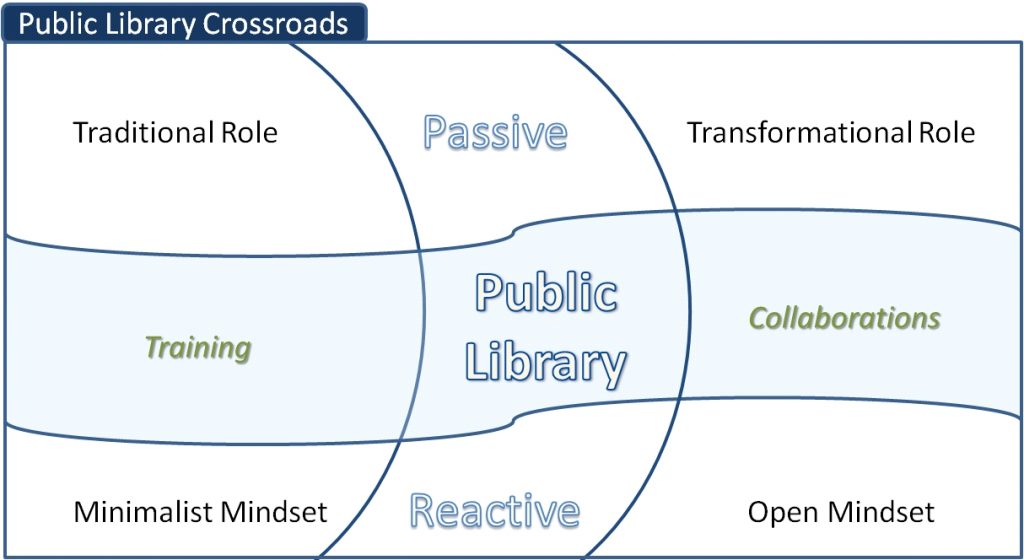
Indeed our libraries are at a crossroads, evolving from resources made from clay tablets to the present day digital information databases! The role of a book repository is speedily facing its demise, libraries are discarding their book collections, crossing over to Dewey less modes and librarians are complementing the vacuum created by the absence shelving or mending books with innovative programs. These facilitate rebranding of the traditional public library. While teachers, nurses and librarians are some of the key the manpower resources of the government, it is the library profession that stands to make a difference to communities around the world due to their unique connections with local residents. The librarians more than ever before are confronted with this responsibility of assisting their governments in promoting sustainability in their local suburb. Working in collaboration with government agencies, librarians potentially can raise awareness about potential threats, promote cohesion, encourage integration, mutual respect and tolerance.
Such ambitions for the public library, as raised by Stripling16, recognise the trusted role and centrality of this intuition’s to local suburb. The findings lend support to recommendations which are tabulated as a model for future library sustainability. The recommendations of this thesis for a model of which encapsulates social integration, sustainability of the library system and moves away from the traditional model as represented in the figure below:
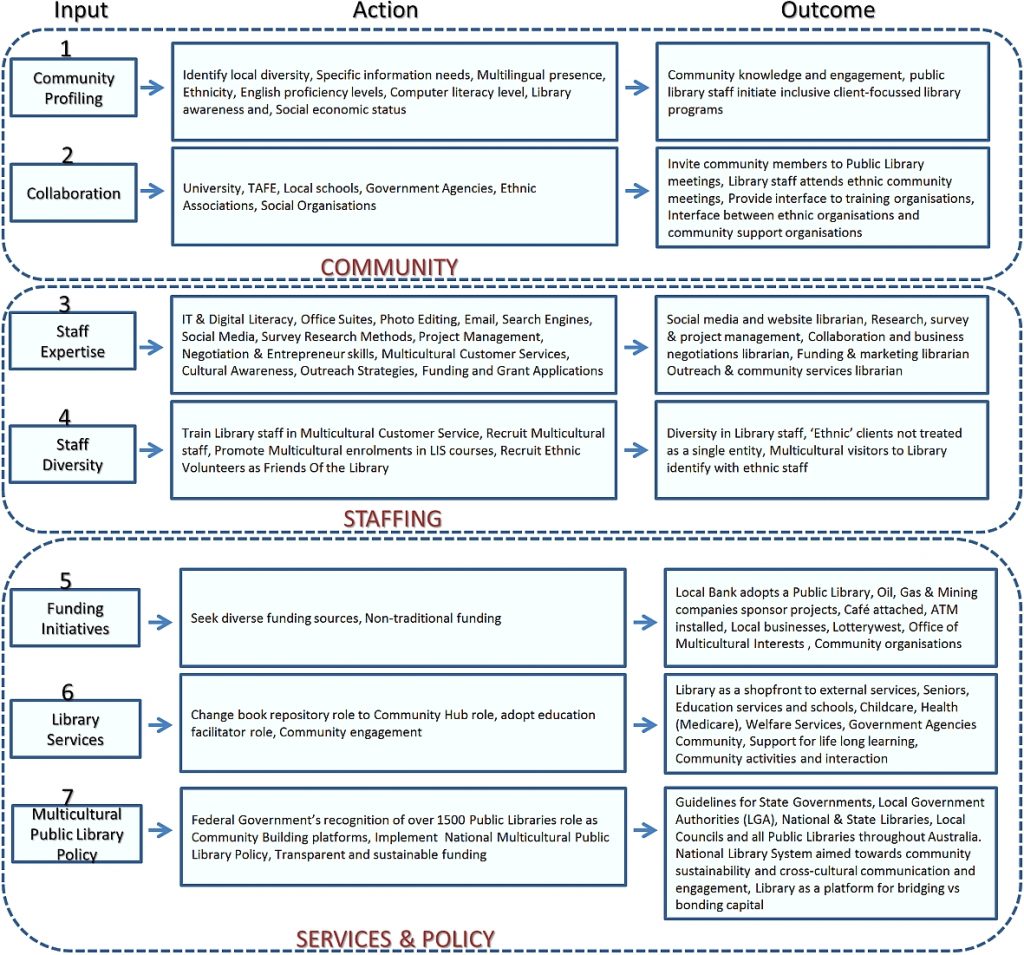
Some elements of the model are based on existing library services and structures, though the actions and outcomes presented here extend these elements. In particular, Input 7 proposes actions and outcomes which advocate that the Federal Government have a more proactive role in developing public library policy at a national level, with a focus on multicultural integration. Elements of the model propose newer roles for the library. In fact, Input 1 is the most critical of all the inputs as it defines, on a per library basis, the demographic profile which would impact on associated actions and outcomes. Input 2 recommends collaborative initiatives these are likely to engage broader participation by business, commercial and educational sectors. Input 5, sees the library collaborating and seeking funds from non-traditional sources (i.e., outside of government), thus, sponsorship and funding for library programs might involve non-traditional stakeholders. Input 3 which promotes staff diversity, could take the form of casual staff members, volunteers, or perhaps the creation of a community liaison role within the library structure.
This model is not designed as a one size fits all solution to library services for multi-ethnic communities. In fact, this diversity is an international phenomenon and it presents service provision with enormous challenges around the world. This thesis acknowledges that perhaps some of these recommendations are viable and it does point towards a shift in perspectives from traditional library practices, to more flexible and outward looking service provision. It also parallels a number of the broad recommendations of the Western Australian Structural Reform of Public Library Services document, which outlines key strategic outcomes17 of:
- well-informed, literate and learning communities
- connected and resilient communities
- community memory
- accessible and relevant content
- community hubs
- skilled and innovative workforce
- continuous improvement
- strategic partnerships
- good governance
- visible and valued.
These strategic priorities proposed by the WA government align closely with many of the recommendations outlined in the model for sustainable libraries outlined above. The broad areas of community, staffing and services and policy seen in the model capture most of the strategic priorities that the WA government put forward in 2007, but are seemingly yet to deliver on in a consistent, identifiable way.
Implications for further research
The findings of this research open a number of avenues of further research. The primary research goal could be to take one or two of the recommendations from the proposed sustainable library model and actually work in collaboration with selected public libraries and community in order to ascertain if these elements of the model were successful in bringing non-library users into the library space. Such a study would be hands on action research, where the researcher is intervening in the traditional library environment in order to bring about the intended outcomes of the model. Such a study would also provide evidence as to the feasibility and practicability of the recommendations.
Another avenue of research, which is implied in the model in Item 4, is conducting a study to ascertain the current level of staff diversity in WA public libraries. The outcomes of such a study could go some way to informing recruitment and training for public library professionals at the state and local council level.
Concluding remarks
Australia as a nation has a rich multicultural heritage and an international reputation of offering new arrivals a ‘fair go’. Within the context of this national diversity, this research has examined the role that public libraries.. The research gathered interview data from a wide variety of participants across a large number of national ethnicities, focusing on their perceptions and understanding of the public library as an organisation and the role (if any) it performed in their community.
Survey data was also collected from library managers and staff as a complement to the interview data, so that both alignment and gaps in service provision could be identified. Participants and library staff do see a measure of recognition for multi-ethnic information needs by libraries and the provision of associated services. However, such alignments are seemingly outweighed by the gap between service provision and service requirement. Part of this gap is driven by the complexities embedded in multicultural communities, their backgrounds and the characteristics that define their understanding of libraries and library services.
The recommendations would require strategic thinking at the federal and state levels of governments, and tactical level of implementation within public libraries and the communities in which they operate. The benefits would be a key role for the library in community building in the short term, and nation building in the long term.
As Australia continues to evolve as a multicultural nation, there exists an opportunity to build sustainable communities, where all members of society have the opportunity to interact and engage in a safe, democratic environment. It is the contention of this thesis that such an environment should have its roots in the public library.
Library and information services are undergoing change at several levels, and library staff are facing increasing demands for skills and new ways of working. The librarians are confronted with a society which is rapidly changing, in terms of technological development as well as social differentiation, diversity and individualization. The knowledge society entails more specialization, and people have rising expectations of quality, effectiveness and service. Our society is characterised by an open economy and internationalization. The library’s role is changing from being a retreat for individual studies to becoming a space for active social interaction, and the library is seeking to be a meeting place and an arena for learning and culture.
Library staff may need to shift from being passive communicators to becoming active producers of content and events. The library managers in particular need skills in how to lead and implement change in libraries, as well as, in how to develop ideas, implement ideas and lead projects through to their completion18. Embrace marketing models, rebrand the traditional image and reinvent the library in alignment with the dramatically shifting demographic dynamics.
References:
- Edmundson, M., & Morgan, G. (2013). Change Readiness: a new commitment to developing a future-fit workforce. Paper presented at the 2013 Library and Information Association of New Zealand Conference, New Zealand. http://www.lianza.org.nz/sites/lianza.org.nz/files/edmundson_mirla_change_readiness_-_a_new_commitment_to_developing_a_future-fit_workforce.pdf; Putnam, R. D. (2000). Bowling alone: the collapse and revival of American community. New York: Simon & Schuster. ↩
- Malone, C. K. (2000). Toward a multicultural American public library history. Libraries & Culture, 35, 77+. ↩
- Molz, K. (1985). From the Territorial Frontier to the Frontier of Science: Library Service in the United States of America. IFLA Journal, 11(2), 91-105. doi: 10.1177/034003528501100203; Walley, E. D., & Davinson, D. (1976). Developments in community information services in public libraries in the United States: a state of the art report and literature guide (Vol. no. 5276.). Leeds: Department of Librarianship, Leeds Polytechnic. ↩
- Laughlin, M., & Latrobe, K. H. (1992). Multicultural aspects of library media programs. Englewood, Colo: Libraries Unlimited.; Molz, K. (1985). From the Territorial Frontier to the Frontier of Science: Library Service in the United States of America. IFLA Journal, 11(2), 91-105. doi: 10.1177/034003528501100203; Smallwood, C., & Becnel, K. (2012). Library Services for Multicultural Patrons: Strategies to Encourage Library Use. Lanham: Scarecrow Press.; Walley, E. D., & Davinson, D. (1976). Developments in community information services in public libraries in the United States: a state of the art report and literature guide (Vol. no. 5276.). Leeds: Department of Librarianship, Leeds Polytechnic. ↩
- Malone, C. K. (2000). Toward a multicultural American public library history. Libraries & Culture, 35, 77+. ↩
- Malone, C. K. (2000). Toward a multicultural American public library history. Libraries & Culture, 35, 77+. ↩
- Brophy, P. (2007). The library in the twenty-first century. London: Facet. ↩
- Smith, K., & Usherwood, B. (2004). The political perception of the public library: an Australian view. Paper presented at the ALIA Conference proceedings. ↩
- Andreas, V. (2009). Public libraries: places creating social capital? Library Hi Tech, 27(3), 372-381. doi: 10.1108/07378830910988504; Audunson, R. (2005). The public library as a meeting-place in a multicultural and digital context. Journal of Documentation, 61(3), 429-441. doi: 10.1108/00220410510598562 ↩
- Varheim, A. (2007). Social Capital and Public Libraries: The need for research. Library and Information Science Research, 29(3), 416-428.; Varheim, A. (2008). Theoretical approaches on public libraries as places creating social capital. Paper presented at the World Library and Information Congress: 74th IFLA General Conference and Council, Quebec, Candada. http://archive.ifla.org/IV/ifla74/papers/091-Varheim-en.pdf; Varheim, A. (2014). Trust and the role of the public library in the integration of refugees: The case of a Northern Norwegian city. Journal of Librarianship and Information Science, 46(1), 62-69. doi: 10.1177/0961000614523636 ↩
- Audunson, R. (2005). The public library as a meeting-place in a multicultural and digital context. Journal of Documentation, 61(3), 429-441. doi: 10.1108/00220410510598562 ↩
- Hoegh-Guldberg, H. (2006). Aged Services Survey for Fairfield City Library Service New South Wales. Australasian Public Libraries and Information Services, 19(1), 39-43. ↩
- Henry-Waring, M. S. (2011, May). Multiculturalism and Visible Migrants and Refugees: Exploring the Yawning Gap Between Rhetoric and Policy in Australia. Melbourne, Victoria. ↩
- Jakubowicz, A. (2006). Anglo- multiculturalism: contradictions in the politics of cultural diversity as risk. International Journal of Media & Cultural Politics, 2(3), 249-266. ↩
- Stripling, B. K. (2014). Equity, Diversity and Inclusion. Retrieved 14-5-2014, 2014, from http://www.americanlibrariesmagazine.org/article/equity-diversity-and-inclusion ↩
- Stripling, B. K. (2014). Equity, Diversity and Inclusion. Retrieved 14-5-2014, 2014, from http://www.americanlibrariesmagazine.org/article/equity-diversity-and-inclusion ↩
- State Library of Western Australia. (2007). Structural Reform of Public Library Services. Retrieved 24-3-2014, 2014, pp. ii-vi, from /http://slwa.wa.gov.au/__data/assets/pdf_file/0017/3536/Structural_Reform-Final_Report_August-web.pdf ↩
- Golten, E. (2012). Competence for innovative libraries. Scandinavian Library Quarterly, 45(3). ↩


